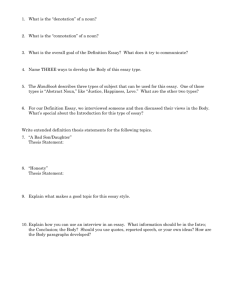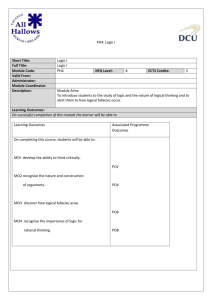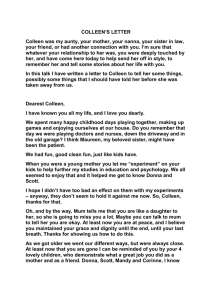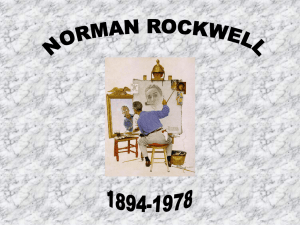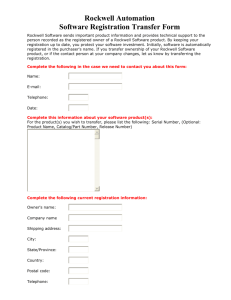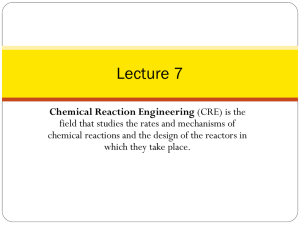Document 13478841
advertisement
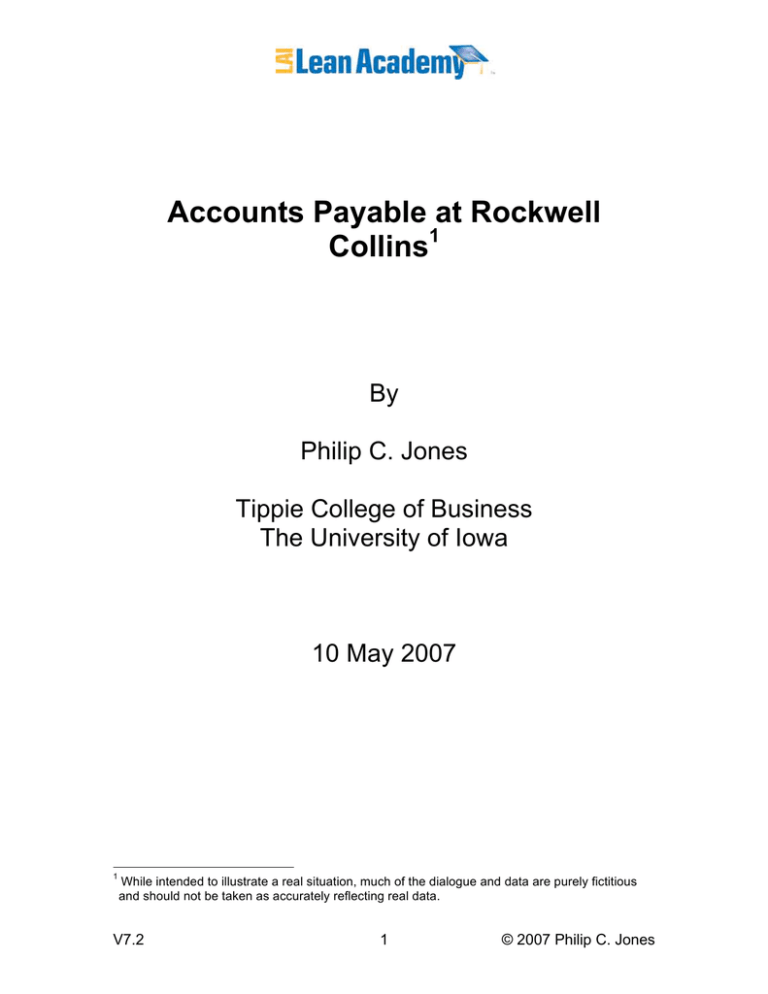
Accounts Payable at Rockwell Collins1 By Philip C. Jones Tippie College of Business The University of Iowa 10 May 2007 1 While intended to illustrate a real situation, much of the dialogue and data are purely fictitious and should not be taken as accurately reflecting real data. V7.2 1 © 2007 Philip C. Jones On the Way to Lunch. “Just a week to go until the Accounts Payable RPI2 event kicks off”, thought Joanie Meyer, Manager of Disbursements at Rockwell Collins, as she made her way to the lunchroom with her colleague, Tom Bednar. As Manager of Disbursements, Joanie oversaw four departments within accounting: The Sales and Use Tax Department; the Payroll, Time, and Expense Reporting Department; the Accounts Payable Department; and the International Accounting Department. Joanie had joined Rockwell Collins after graduating from college with her accounting degree and had worked for the company ever since. When Rockwell Collins had been spun off from Rockwell International in 2001, Joanie had wondered how well the spin-off would work. Although initially Rockwell had faced some cash-flow problems, the company had successfully dealt with those issues and was now rapidly gaining market share from its competitors in commercial and military avionics. Joanie recalled how Rockwell’s new CEO, Clay Jones, had developed and pushed Rockwell’s “Lean Electronics” initiative not long after he had taken over. After first seeing some successes in applying lean principles to the manufacturing floor, Rockwell had begun trying to apply the same principles to other functional areas. “I remember our first RPI event in 1999”, thought Joanie to herself. “We managed to reduce the cycle time on payout of expense reports from 5 weeks to 1 week, but after six months we were right back where we started. Whatever we do this time”, decided Joanie, “We’ve got to follow through to make sure any improvements are lasting.” Rockwell Collins Background Rockwell Collins is a leading provider of commercial and military avionics systems and information technology. Key customers include aircraft manufacturers, airlines, and government. The company was founded as Collins Radio Company in 1933 by Arthur Collins who had invented, developed, and produced innovative short wave radio equipment that was made famous through providing a communications link for Admiral Richard Byrd’s 1933 expedition to the South Pole. In 1973, Collins Radio was acquired by Rockwell International. Today, Rockwell Collins is once again an independent company with approximately 17,000 employees in over 60 locations in 27 countries. Joanie’s Accounts Payable Department was currently staffed with 16 full-time personnel. Rockwell had begun implementing its invoice-less PFR3 system in 2 3 Rapid Process Improvement (RPI), a name for a Kaizen continuous improvement process Pay from Receipt (PFR) V7.2 2 © 2007 Philip C. Jones 1993 with the goal of eventually using PFR on any purchase involving the receipt of some type of material and had started its SAP4 implementation in 1999. To date, about 80% of transactions have been converted to PFR status; the remainder, however, require some manual processing and approval, and it is those that had been giving the greatest problems. A simplified description of how Rockwell’s PFR system pays vendors breaks the mechanics into three parts. First, the purchasing department enters a PO5 into the SAP system. Second, the receiving department enters data into the SAP system upon receipt of the material. Third, the SAP system triggers a vendor payment when the PO and the receipt information are reconciled. One feature of Rockwell’s PFR system is that vendors do not bill Rockwell for either freight or sales tax. Instead, vendors charge Rockwell’s freight account directly for freight charges and Rockwell self-assesses sales taxes. A Meeting with Don Joanie recalled her meeting with Don Doudna, the Assistant Controller to whom Joanie reported. “Just look at this”, Don had said as he had pointed to a column of numbers in a spreadsheet. “We’ve got over 10% of our accounts overdue, and our suppliers are not happy campers. In some cases, it’s even impacting further shipments of parts, causing our manufacturing plant to miss shipping due dates.” “Additionally”, Don had continued, “our cycle time through the Accounts Payable process has been running at about 6 weeks, a pretty big increase over last year. Somehow, you’ve got to get a handle on this.” Collaborating with Colleen Following that meeting, Joanie had spent some time with Colleen Kelly, the manager of her Accounts Payable Department to better understand the process. In an initial walk-through, Joanie wondered if there was anything obvious she could see that would help pinpoint a problem. Although no single thing really jumped out at her, Joanie couldn’t help but notice that everyone seemed very busy. Five of the 16 analysts were examining microfilm records at the microfiche readers when she started her walkthrough, and there seemed to be a constant parade of analysts between their work areas and the microfiche readers. Eight of the remaining 11 analysts were on the phone, talking with suppliers who had called in to inquire either about getting paid or about why they were paid incorrectly. The remaining three were all engaged in combing through the massive stacks of paper computer printouts that covered the desks of all the analysts. Throughout her walkthrough, ringing phones provided a constant distraction from her discussion with Colleen. 4 5 SAP is enterprise wide data base software Purchase Order (PO) V7.2 3 © 2007 Philip C. Jones Thanking her lucky stars that she had instructed Colleen to begin tracking some processing metrics last year, Joanie noted, “You folks certainly keep busy down here, Colleen. You remember the AP6 quarterly metric analysis we developed last year? Can you grab the summary sheets for the past 4 quarters and meet me in my office in 15 minutes? (See Table 1) We need to take a close look at where we are with this and in particular, see if there are any noticeable trends.” After completing their discussion of the summary sheets, Joanie and Colleen agreed that a good next step would be to complete a formal VSM7 of the Accounting Invoice Resolution Process. “We need to start the VSM at the point that we receive incoming mail from suppliers”, said Joanie. “Sounds right to me”, said Colleen. “I’ll set up a quick meeting next week with the mailroom people and some of our AP folks who have been heavily involved in the process. It’d help out if you’d come to kick off the VSM meeting to let our folks know what level of detail you’re looking for.” The VSM Meeting. At the VSM kickoff, Joanie explained that she wanted the VSM to start with the event of receiving incoming mail, and continue until the invoice is resolved and the resolution is recorded to microfilm. At the VSM meeting, Bill Hutchins from the mailroom patiently explained what happened to incoming mail. “After it’s received”, said Bill, “it’s got to be opened and examined to determine whether or not it belongs to AP. If it’s not, then we have to re-route it to the right department.” “What happens next if it doesn’t have to be re-routed?” asked Colleen. “Well, in that case”, commented Bill, “we have to check to see if it has a Purchase Order (PO) or not. If it doesn’t, then we have to follow up with a call to the vendor contact person to straighten that out. On the other hand, if it does have a PO (or once we get the PO issue straightened out with the vendor), we next have to check to see whether or not the Purchase Order is for an item on the PFR system.” “Okay”, Colleen said, “I get the picture. If it is a PFR item, then you just toss it since it’s already been paid for off the PFR system. If not, then it goes to the 6 7 Accounts Payable (AP) Value Stream Map (VSM) V7.2 4 © 2007 Philip C. Jones appropriate analyst. Since we’ve assigned companies to analysts alphabetically, that should be pretty straightforward”. “Yes”, said Bill, “it is. Companies whose name starts with an Aa through Be go to Sullivan, and so on. What gets me though is why we get all those invoices for PFR items. The vendors know they’re on the PFR system and we don’t need an invoice to pay them.” “You’re right”, asserted Colleen. “The problem is that some of the vendors are running accounting software that forces them to generate and send an invoice. We’ve talked to some of them about this, but it’s just too expensive for some of them to change systems to meet the needs of only one customer. Still, it’d sure be nice to do something about that.” “Anyway”, continued Colleen, “let’s try to nail down what happens once the PO gets to the analyst. Nicole, you’ve been working as an analyst for 5 years, how do you see the process?” “Well, said Nicole, “the first thing I have to do is check to see whether it’s a PFR item or not.” “Why on earth is that?” asked Bill. “We’ve already checked for that in the mailroom.” “Yes, and you do a good job of catching almost all of them”, agreed Nicole. “Still”, she observed tactfully, a PFR item does slip through from time to time, so we still have to check.” “Nicole, how long does it take to check whether or not an item is PFR?” asked Colleen. “Well”, said Nicole, you know that we have to get into the SAP system to look it up. Probably, on average, that takes about 6 to 7 minutes.” “Okay”, said Colleen. “And if it is a PFR item, you toss it just like they do in the mailroom and otherwise it gets processed. So how do you see the rest of the process going?” “What happens next”, stated Nicole “is that I determine whether or not it is ready to pay. If it is, I send it to Input where it is paid and the records are batched and microfilmed. If it isn’t ready to pay, then I put it in a pile on my desk to work on later. When the issue is resolved, it goes to input where it is paid, and then the records are batched and microfilmed.” “Why do you put it in a pile to work on later?” asked Colleen. “Couldn’t you just work on it immediately?” V7.2 5 © 2007 Philip C. Jones “Well, sure”, said Nicole. “Whether I work on it immediately or not, it takes about a minute to resolve. But the thing is, if I do work on it immediately, it throws me completely off my stride in checking for Ready to Pay. All of us analysts have tried completing the resolution before continuing on with the Ready to Pay checks, but it just doesn’t seem to work---it slows us up way too much. So setting the items needing resolution aside until we complete the entire batch of Ready to Pay checks seems to be the only way to go.” The meeting continued for several more hours. At the end of that time, Colleen had painstakingly collected the data shown in Tables 2 and 3. Colleen and Joanie met once more to discuss the results of the VSM and decided based on the VSM to initiate an Accounts Payable RPI to determine how best to improve the process. The RPI event was scheduled for 3 days and would require 12 team members, 2 RPI workshop leaders, and 5 on-call “experts”. Continuous Collaboration with Colleen After the VSM working group had completed mapping the Invoice Resolution Process Joanie met once more with Colleen to discuss the results. “Colleen”, Joanie sighed, “Good job on the Value Stream Map. Looking at it reminds me of something you said during our walk-through. It’s been nagging at me, and I hope you can clear this up for me. You said that some of the people on the phones were responding to inquiries from vendors who had been paid incorrectly. I thought our payment procedures were pretty good, and it surprises me that there would be a significant number of payment errors. Do you have any idea what our error percentage is and what is causing these errors?” “Well”, said Colleen, “I’m not sure of the exact error percentage, but I’d estimate it as around 5 percent. Even worse, that’s 5% of our PFR items, not 5% of our non-PFR items. So every time we have an error, one of my analysts has to spend a bunch of time running down what the right amount is and making the appropriate corrections.” “How much time”, asked Joanie, “is that chewing up?” “The analyst can spend anywhere from a few minutes to several hours researching a given issue”, noted Colleen, “but 30 minutes is a reasonable average figure”. “As you know”, mused Joanie, “payment on PFR items is based on combining a PO with a recorded receipt by receiving and the whole process is automated, so there should never be any errors on our (Rockwell’s) end unless one of the two inputs is fouled up.” V7.2 6 © 2007 Philip C. Jones “Why should either of those inputs be wrong?”, asked Colleen. “I’m not sure”, noted Joanie, “but it’s something I want you to pay close attention to in the RPI event once we get it off the ground. Even if you can’t nail every possible cause down exactly, you should be able to come up with some pretty reasonable ideas that we can follow up on.” “In addition”, Joanie continued, “I’m really curious about how much of our total analyst capacity is tied up in dealing with these erroneous PFR items. Furthermore, if we could eliminate doing so, what impact would there be on our total flow time? As you know, right now it’s running over 6 weeks which is completely unacceptable.” To gain approval for the RPI, Joanie had to meet with her management one more time. Another meeting with Don and (this time) Dave “We’re going to approve your proposed RPI”, said Don. Don had told Joanie her main objective with the accounts payable RPI had to be to reduce cycle time on paying accounts. “It’s key”, he had emphasized, “that we develop a standard process for document invoice resolution that doesn’t exceed 10 days. If you can get it shorter, then so much the better. You should also make sure that you establish a training plan for everyone whose work is affected by anything you change. Finally, we need to formalize how we are going to communicate requirements for invoice payments to our suppliers.” In the same meeting, Don’s supervisor Dave Brehm who was VP, Finance and Corporate Controller had given Joanie some additional input. “Whatever you do”, Dave had emphasized, “it’s got to be accommodated within our new SAP system. Any software or information technology you think you need has got to be based on systems already available inside the company. Additionally, all action items need to be completed within 30 days. Finally, there’s no way I can authorize any additional staff. I want you to know, however, that I’m impressed with the thoroughness of your planning and follow-through on this.” Finally Making it to Lunch. As they ate lunch, Tom and Joanie discussed what Joanie had learned since meeting with Don and Dave. V7.2 7 © 2007 Philip C. Jones “Tom, I wonder”, mused Joanie, “why it is that our total flow times are so long. Just looking at the average processing times for each individual step, it seems like we ought to get things done quicker than we do.” “That is a real non-plusser”, agreed Tom. “Maybe we can raise that question at next week’s RPI. At first, I thought it might be because our assignment of companies to analysts might be unbalanced, but looking at the yearly totals, it seems that you’ve split the workload pretty evenly amongst the analysts.” “Maybe”, continued Joanie, “it has something to do with the fact that the analysts are spending a lot of their time responding to vendor inquiries. They sure do spend a lot of time on the phones with vendors. What makes it worse is when an analyst is sick or goes on vacation.” “What do you mean?” asked Tom. “Just to give you an instance”, responded Joanie, “last month Rhonda was out for 3 weeks on her annual vacation. During those three weeks nothing got done on any of the accounts for the companies she handles. Part of the problem is that every analyst uses a completely different filing system. Nobody could find the information to let any of Rhonda’s vendors know what their status was on any of their past due invoices when they called.” “I see,” said Tom. “And so stuff just piles up on their desk while they’re gone.” “It’s even worse than that”, Joanie observed as she finished off her cream of vegetable soup and started in on her salad. “In a few cases, vendors called and nobody could find any record of their invoice having ever been entered into the system. We had to tell them to re-send the invoice; and when it arrives we’ll have to start the whole process from scratch.” “Well,” observed Tom, it sounds like the RPI event has some good issues to go to work on. Let me know if I can help.” V7.2 8 © 2007 Philip C. Jones Table 1. Quarterly AP Metric Summaries 1st Quarter 2nd Quarter 3rd Quarter 4th Quarter 13700 14500 15200 15600 Average Cycle Time (weeks)8 5.8 6.1 6.3 6.4 % Past Due 8% 10% 11% 12% Total Incoming Invoice Volume (nearest hundred) Table 2. Total Volumes for Most Recent Fiscal Year (nearest thousand) Processing Step Total Annual Volume Mail Received 325,000 Mail Re-routed 25,000 Mail with no PO 5,000 PFR Items (mailroom) 240,000 PFR Items (analyst) 1000 Needs to be Resolved 5,000 Table 3. Average Times for Various Processing Steps9 Mailroom Steps AP check PO check Reroute Vendor Contact PFR check Send to Analyst Analyst Steps PFR check Ready to Pay check Input to issue check Records batch Microfilm Park & Resolve 1 minute 2 minutes 1 minute 30 minutes 6.5 minutes 1 minute 6.5 minutes 5 minutes 2 minutes 2 minutes 4 minutes 1 minute 8 Average Cycle Time here means the average time an incoming item spends in the system until it has completed processing. 9 Includes only the time from the start of a given step until that step is completed. V7.2 9 © 2007 Philip C. Jones Table 4. Incoming Mail by Analyst Number10 Analyst # 1 2 3 4 5 6 7 8 9 10 11 12 13 14 15 16 wk 1 52 78 55 52 86 72 60 89 82 74 84 78 85 59 82 53 wk 2 61 93 76 83 74 57 85 92 88 75 84 76 80 60 83 67 wk 3 68 79 79 62 79 58 63 73 71 56 61 51 55 71 75 87 wk 4 56 83 93 71 55 89 59 76 85 62 58 71 62 71 81 69 Year 3766 3816 3893 3682 3615 3742 3746 3792 3834 3723 3702 3694 3799 3696 3692 3814 Table 5. Analyst Workday Summary Number AP Analysts Average Annual Vacation Holidays Workday Breaks Lunch Standup meetings Housekeeping/5S 16 20 days 10 days 7:00 AM to 3:30 PM Two 15 minute breaks (morning and afternoon) 30 minutes 10 minutes 10 minutes 10 Provides total incoming mail for the most recent fiscal year as well as totals for each of the past 4 weeks. V7.2 10 © 2007 Philip C. Jones MIT OpenCourseWare http://ocw.mit.edu 16.660J / ESD.62J / 16.53 Introduction to Lean Six Sigma Methods IAP 2012 For information about citing these materials or our Terms of Use, visit: http://ocw.mit.edu/terms.
